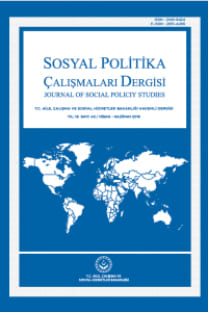İSPANYA’DA KAMU İDARELERİ İLE SİVİL TOPLUM ÖRGÜTLERİNİN ENGELLİLİĞE İLİŞKİN TOPLU HAREKETLERİNİN İLİŞKİSİ
Kamu idareleri ile Sivil Toplum Örgütlerinin toplu hareketleri arasındaki ilişki İspanya’da oldukça yenidir. Örgütlerin sürekli aktiviteleri nedeniyle pek çok önemli adım atılmış olsa da, bu adımlar örgütsel hareketlerin oldukça büyüdüğü son yirmi yıla odaklanmıştır. Bu çalışma, yirminci yüzyılın son ikinci yarısında İspanya’nın tarihi gelişmesinin örgütlerle olan ilişkisine ve aynı zamanda günümüzde engelli insanların erişimlerini ve haklarını koruyup destekleyen düzenlemelere, kanun ve yasalara odaklanmaktadır ki, toplu örgütlenmelerin ana odağı ve varlık nedeni de budur. Makale aynı zamanda günümüzdeki durumu tasvir etmekte, kamu idareleri ile sivil toplum örgütlerinin beraberce ve Avrupa Birliği ve diğer yüksek mercilerin getirdiği yeni kurulan bağlantılarla nasıl çalıştığıyla ilgili örnekler sunmaktadır. Durumu daha iyi açıklayabilmek için Madrid’de bulunan Omurilik Hasarı Vakfı’nı içeren bir vaka örneği sunulmuştur.
Anahtar Kelimeler:
Fon, engellilik, toplu örgütlenme, İspanya, STK
PUBLIC ADMINISTRATION AND THE ASSOCIATIVE MOVEMENT OF NON-GOVERNMENTAL ORGANIZATIONS IN SPAIN
The relationship between Public Authorities and the Associative Movement of Non-Governmental Organizations (hereinafter P.A and NGOs, respectively) in Spain is fairly recent. Although great advances have been achieved due to the constant activity of the associations, the focus on these advances has to be localized within the last twenty years, in which the associative movement has progressed enormously. This paper focuses in the progression of the movement related to the historical development of Spain in the second half of the twentieth century, as well as the current situation regarding regulations, laws and orders that defend and promote accessibility and the rights of people with disabilities, which are the main focus and raison d’être of the associative movement. The review also describes the current situation and provides examples on how the relationship between Public Administration and NGOs works currently, as well as the newly founded links with new initiatives aligned with the development lines of the European Union and higher entities. A case study to further explain this situation is also included, applied to the Spinal Cord Injury Foundation in Madrid.
Keywords:
Funding, disability, associative movement, Spain, NGO,
___
- Alberich Nistal, T. (2007). Asociaciones y movimientos sociales en españa: Cuatro décadas
- de cambios. Revista Injuve Jóvenes, Globalización Y Movimientos Altermundistas,76,
- pp. 71-90.
- Blanco, A. (2010). Las aportaciones de la sociología española a la Responsabilidad Social
- Empresarial. Revista Internacional de Sociología, 68, pp. 577-602.
- Consejeria De Políticas Sociales Y Familia De La Comunidad De Madrid. (2012). Tercer
- Plan de Acción para personas con discapacidad 2012-2015 (pp. 137-156). Madrid:
- B.O.C.M.
- Cortés Alcalá, L. (1992). La modernización de la sociedad española. Documentación
- Social, 88, pp. 57-76.
- López Morante, G. (2000). La Estrategia de las entidades no lucrativas en el ámbito de la
- discapacidad en el municipio de Madrid. Madrid: B.O.C.M.
- Ministerio De Empleo Y Seguridad Social. (2014). Estrategia española de responsabilidad
- social de las empresas. Retrieved on December 2015 from http://observatoriorsc.org/
- estrategia-espanola-de-responsabilidad-social-de-las-empresas/.
- Ministerio De Sanidad, Servicios Sociales E Igualdad. (2013). Real Decreto Legislativo
- /2013, de 29 de noviembre, por el que se aprueba el Texto Refundido de la Ley
- General de derechos de las personas con discapacidad y de su inclusión social.
- Boletín Oficial del Estado (Chapter 12632, num. 289), pp. 95635-95673.
- Reichmann, J. and Fernández Buey, F. (1994). Redes que dan libertad. Introducción a los
- nuevos movimientos sociales. Barcelona: Paidós.
- Rodriguez Cabrero, G. and Ortí Benlloch, A. (1996). Las entidades voluntarias en España.
- Institucionalización, estructura económica y desarrollo asociativo. Madrid: Ministerio
- de Asuntos Sociales.
- WHO (World Health Organization). (2011). Informe mundial sobre discapacidad. Retrieved
- on December 2015, from http://apps.who.int/iris/bitstream/10665/70672/1/WHO_
- NMH_VIP_11.03_spa.pdf.
- ISSN: 2148-9424
- Yayın Aralığı: Yılda 4 Sayı
- Başlangıç: 2012
- Yayıncı: Aile,Çalışma ve Sosyal Hizmetler Bakanlığı
Sayıdaki Diğer Makaleler
ENGELLİLERDE SPORTİF BECERİ VE KOORDİNASYON EĞİTİM PROGRAMLARI
Doç. Dr. Yaşar TATAR, Doç. Dr. Selda UZUN, Doç. Dr. Nusret RAMAZANOĞLU
2012 TÜRKİYE SAĞLIK ARAŞTIRMASI’NIN ENGELLİLİĞE İLİŞKİN YAYGINLIK ÖLÇÜMÜ AÇISINDAN İNCELENMESİ
ENGELLİLERİN SOSYAL SORUNLARI VE BEKLENTİLERİ
Miguel Ángel GARCÍA OCA, Natacha LEÓN ÁLVAREZ, Luis JAÉN CAPARRÓS
ENGELLİLERE YÖNELİK ÜLKEMİZDEKİ ÖZEL EĞİTİM HİZMET UYGULAMALARI VE ÖRNEK ÜLKE KARŞILAŞTIRMASI
